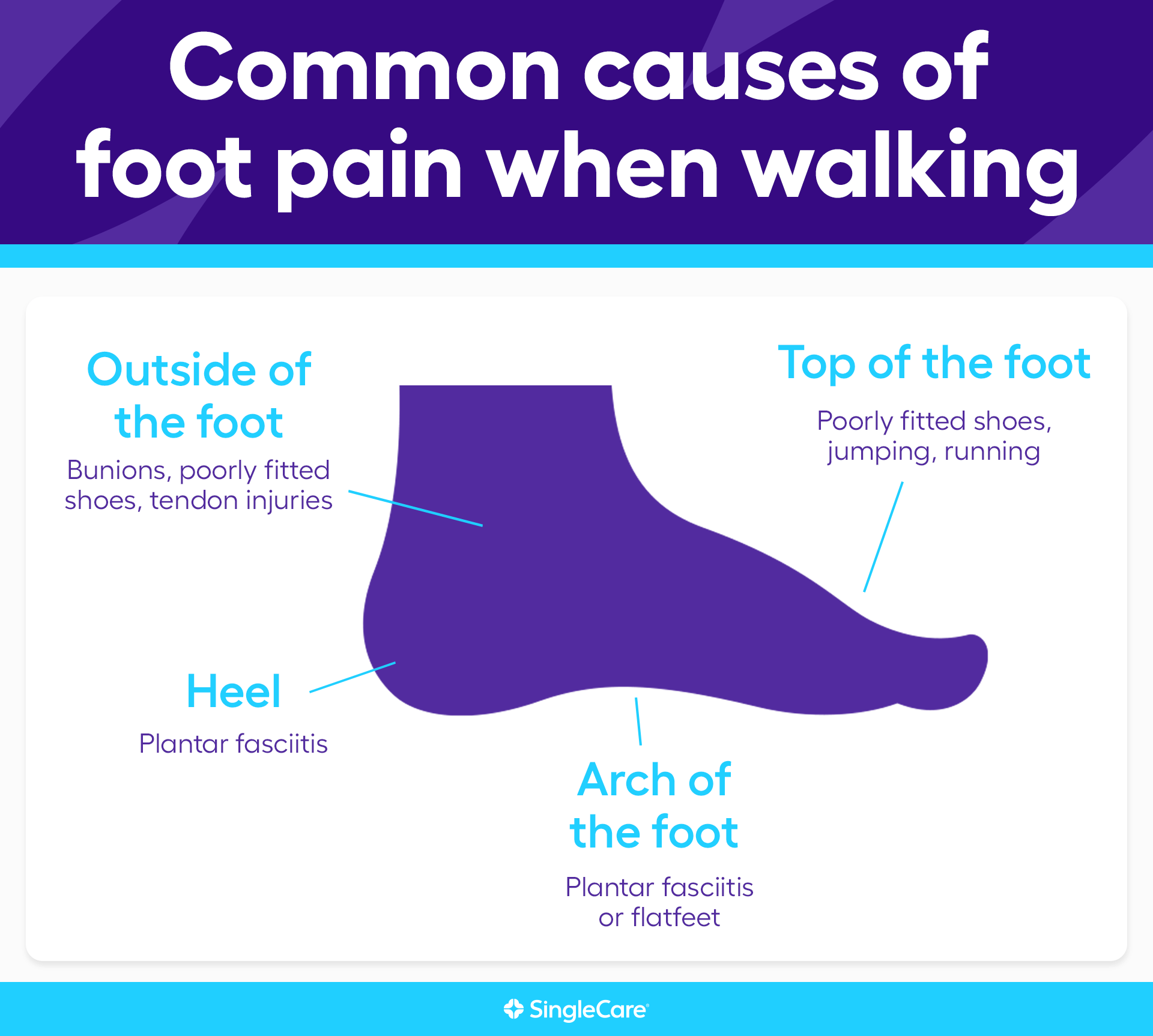Foot pain is a common problem. It has many causes ranging from bad shoes to serious infections. Depending on the cause, foot pain can be focused on one small part of the foot or it can affect the entire foot. The pain can be intermittent or constant. The pain might be a minor irritation to something so severe it’s hard to walk or do daily tasks. Foot pain can be dull, sharp, throbbing, or burning pain. Because the foot supports the weight of the entire body, even a small amount of pain can significantly interfere with daily functioning and quality of life. Fortunately, most foot pain either resolves on its own or gets better with treatment, usually in a short time if not ignored.
Foot pain is caused by overuse, injury, anatomical irregularities, medical conditions, and drugs.
Most people will experience foot pain due to overuse. Inflammation caused by mechanical stresses on the foot is what produces the pain. The most common causes are:
Overuse can also injure the foot and cause:
Some people have irregularities or abnormalities in their feet that raise the risk of overuse pain or overuse injury. These include:
Injuries due to trauma can also cause foot pain including:
Ill-fitting or inappropriate footwear can also cause injuries including:
Medical conditions that can cause foot pain include:
Arthritic conditions including rheumatoid arthritis, osteoarthritis, traumatic arthritis, and gout
Blood vessel disorders including blood vessel swelling (vasculitis), Raynaud’s phenomenon, peripheral artery disease (PAD), peripheral venous insufficiency, and blood clots
Nerve disorders including pinched nerve, tarsal tunnel syndrome, Morton’s neuroma, and nerve damage due to diabetes or chronic back conditions
Infections including fungal infections (like athlete’s foot), cellulitis, human papillomavirus (HPV, the virus that causes plantar’s warts), and gangrene due to blood vessel damage especially with diabetics
Skin conditions such as contact dermatitis, psoriasis, cracked heels with deep fissures, and diabetic foot ulcer
Fibromyalgia
Some prescription medications may cause peripheral nerve damage which can cause numbness, tingling, weird sensations, or pain in the foot or toes. These include:

Foot pain isn’t a reason to worry if the cause is known and relatively harmless. For instance, foot pain due to standing too long or stubbing a toe doesn’t require medical help. Most foot pain of this sort can be managed by either waiting it out, resting the foot, or putting ice on it to reduce swelling. Some cases of foot pain may need medication, like athlete’s foot.
Sometimes, foot pain is something to worry about and requires help from a medical professional. Long-lasting or severe pain, serious injuries, or bad sores should be assessed by a healthcare professional particularly if things are not improving on their own. If left untreated, some severe cases of foot pain can lead to serious complications like permanent damage to the foot, deformity, or amputation. Some severe cases like multiple fractures, frostbite, or an Achilles tendon rupture may require emergency treatment, maybe even surgery.
Healthcare professionals use a variety of diagnostic tools when trying to figure out the cause of foot pain, but they mainly rely on a medical history, symptom history, and careful examination of the foot. Be prepared to answer questions about where the pain is, when it started, what triggers it, how long the pain has lasted, and what helps make the pain get better.
The healthcare provider will carefully examine the foot both at rest and when standing. Joints will be examined and the healthcare provider will push on parts of the foot. The range of motion will be tested. The healthcare provider may move the foot to put stress on parts of the foot.
In many cases, a history and careful physical examination of the foot are enough to make a diagnosis. Additional tests are used to confirm the diagnosis, usually an X-ray, MRI, CT scan, or ultrasound.
Depending on the cause, foot pain can last for a few minutes, a few days, months, or a lifetime. Most cases are transient. The pain passes in a few minutes or a few hours. Some conditions, however, may cause pain for days or months. Some conditions, like arthritis, may mean the foot will hurt off and on for a lifetime.
In most cases, foot pain will resolve on its own or resolve with a few home remedies, like rest, icing, or elevating the foot. Some causes of foot pain like athlete’s foot or plantar’s wart go away in one or two weeks with appropriate treatments.
More serious injuries and medical conditions like rheumatoid arthritis, damage to the Achilles tendon, or bone breaks will require help from a medical professional, usually a doctor such as a podiatrist, orthopedist, or neurologist.
Drugs that are used to help relieve foot pain include over-the-counter pain relievers, prescription pain relievers, and corticosteroid injections.
Depending on the cause, other treatment options for foot pain may include activity modification, orthotics (supportive shoes, arch supports, heel pads, or shoe inserts), taping, splints, braces, walking boots, casts, massage, stretching, strengthening, physical therapy, laser therapy, shockwave therapy, platelet-rich plasma injections, amniotic fluid injections, or surgery. Surgery is usually used as a last resort when other less risky treatments have failed.
Most foot problems can be handled without a doctor by using a few home treatments:
Anti-inflammatory NSAIDs like ibuprofen can provide pain relief and reduce swelling
Resting the foot
Icing the painful or swollen part of the foot
Compression or taping the foot or ankle to limit movement
Elevating the foot
Rigid shoe inserts or restrictive shoes for bunions
Wearing appropriate and properly fitted shoes for corns or calluses
Shoe inserts or cushioning for pain in the ball of the foot
Plantar fascia strengthening exercises for plantar fasciitis
Topical salicylic acid for plantar’s warts and corns/calluses
Topical antifungal medications for athlete’s foot and nail fungus
Most foot pain is due to overuse or injuries. However, some medical conditions can cause foot pain including arthritis, nerve disorders, foot deformities, blood flow problems, skin disorders, and infections.
What diseases can cause pain in the feet?
Infections that can cause foot pain include athlete’s foot, fungal infections of the toenail, plantar’s warts, and bacterial infections of the skin. Vascular diseases involving the arteries and veins in the feet can also be responsible for foot pain and need the appropriate medical attention.
Walking usually makes foot pain worse because of all the weight and stress put on the foot. Where that pain occurs could identify a possible cause:
Pain on the outside of the foot when walking: this is very common and is due to several possible problems including bunions, badly-fitted shoes, and tendon injuries
Pain in the heel: the most common cause of heel pain is plantar fasciitis, an overuse injury of the ligament that stretches from the heel to the ball of the foot
Sharp pain in the arch of the foot when walking: the most common cause of sharp arch pain is plantar fasciitis but people with flatfeet are also prone to have arch pain
Sharp pain on the top of the foot when walking: poorly fitted shoes, high heels, jumping, and running are the usual suspects
Most people with heel pain have plantar fasciitis, an overuse injury of a ligament that starts at the heel and extends to the ball of the foot. The pain worsens when the ligament is stretched by flexing the foot.
Foot pain usually feels better when people take the weight off the foot by sitting or lying down. That’s not always true, though. Nerve and vascular disorders can cause the feet to continue hurting at rest … or hurt even worse.
Diabetic foot pain is largely due to nerve damage caused by restricted blood flow to areas in the foot. Diabetic neuropathy typically feels like tingling or burning. Symptoms appear to be worse at night when resting. As the nerves progressively get worse, the affected area will start feeling numb.








